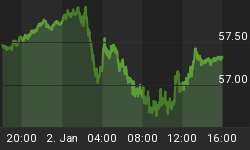originally published October 18th, 2015.
Gold's cheerleaders are at it again, jumping up and down with excitement as they proclaim the birth of a new bullmarket, and herding their flocks into the sector, when they have barely recovered from the last fleecing.
There are 3 factors that we are going to look at which suggest that this latest rally is just another false dawn. One is the unbroken downtrends in gold and silver, the next is the unfavorable alignment of their moving averages, and finally their latest COTs, which call for caution - especially silver's which is downright bearish.
On gold's 5-year chart we can that it is still well within a continuing downtrend and the picture cannot start to be considered to be bullish until it breaks out above this resistance and the nearest resistance level shown and its moving averages swing into bullish alignment. Currently its 50-day moving average is way below its 200-day, a setup which makes a reaction back more likely.

On gold's 6-month chart we can see recent action in more detail and how it appears to be stalling out in the vicinity of its 200-day moving average, where it is overbought. Moving averages are still bearishly aligned - despite them turning up the 50-day is still way below the 200-day.

On gold's latest COT we can see that the Commercials' short positions have been expanding as gold has advanced this month. Although they are not yet at extreme levels, silver's are, and that makes a reaction back soon likely.

If gold and silver are set to react back soon, then it implies that the dollar will strengthen. As we have observed in the recent past, the dollar index has been weakening and dropping back towards key support at 92.5 - 93, which, if it fails, would be expected to lead to a potentially steep drop. However, with the Precious Metals COTs showing marked deterioration, and the dollar's COT improving significantly, it looks like the dollar's key support will hold, for a while at least, and probably generate a rally. This of course would set off a PM sector reaction.

It is widely assumed in some quarters that the Fed wants to see the dollar drop because it would take pressure off US exporters and generally be better for the economy, but those who believe this don't understand the Fed's priorities. The Fed's main priorities are looking after the interests of the big banks and Wall St, with whom it has a very cozy relationship. Bearing in mind its own bloated balance sheet, it is easy to deduce that it doesn't want rates to rise, because it would create problems with respect to its own debt burden, and would rig rip the rug out from under the stockmarket. So it is quite happy to see the dollar stay high, as it gives it a buffer against raising rates. It is not interested in the effects of the high dollar either on savers or on exporters or even on the economy - as far as it's concerned that's their problem. It is not known how much leverage the Fed can bring to bear to keep the dollar from breaking down, but if they could somehow encourage a further unwinding of the global carry trade, by using the controlled media to manage perceptions, they could largely get the markets to do the heavy lifting for them, so that they need not intervene significantly to stop the dollar breaking down.
Latest COTs indicate that the current rally in the Precious metals will now quickly reverse implying that the dollar will now rally away from the danger zone at the lower boundary of its recent large trading range. Although this doesn't mean that it won't break down later. This also makes it likely that other commodities will turn down shortly too.
















